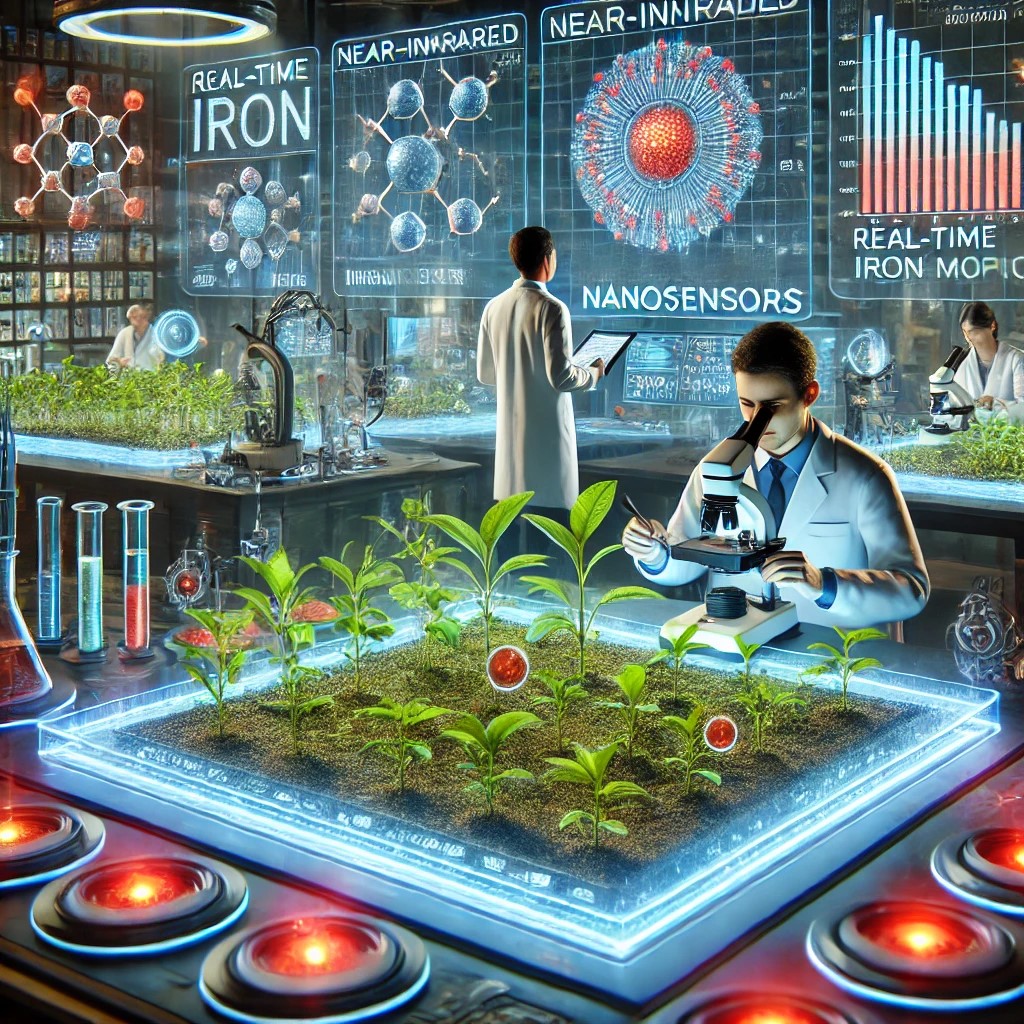SMART Researchers Develop Nano sensor for Real-Time Iron Monitoring in Plants
Researchers from the Disruptive and Sustainable Technologies for Agricultural Precision (DiSTAP) group at the Singapore-MIT Alliance for Research and Technology (SMART), MIT’s research enterprise in Singapore, in collaboration with Temasek Life Sciences Laboratory (TLL) and MIT, have developed an innovative near-infrared (NIR) fluorescent nanosensor that can simultaneously detect and distinguish between iron forms—Fe (II) and Fe (III)—in living plants.

Figure 1. SMART Researchers Pioneer Nano sensor for Real-Time Plant Iron Detection.
Iron is essential for plant health, playing a vital role in photosynthesis, respiration, and enzyme function. It exists primarily in two forms: Fe (II), which plants can readily absorb and use, and Fe (III), which must be converted into Fe (II) before becoming bioavailable. Traditional methods measure only total iron, overlooking the critical distinction between these forms. By differentiating Fe (II) from Fe (III), researchers can gain deeper insights into iron uptake efficiency, diagnose deficiencies or toxicities, and develop precise fertilization strategies—optimizing agricultural productivity while minimizing waste and environmental impact. Figure 1 shows SMART Researchers Pioneer Nano sensor for Real-Time Plant Iron Detection.
The pioneering nano sensor developed by SMART researchers offers real-time, nondestructive monitoring of iron uptake, transport, and conversion between its different forms, providing unprecedented insights into iron dynamics. With high spatial resolution, it enables precise localization of iron within plant tissues and even at the subcellular level, detecting minute changes that reveal how plants respond to stress and utilize nutrients.
Unlike traditional methods, which are either destructive or limited to detecting a single iron form, this nano sensor allows for accurate diagnosis of deficiencies and optimization of fertilization strategies. By identifying imbalances in iron levels, adjustments can be made to enhance plant health, minimize waste, and promote sustainable agriculture. While initially tested on spinach and bok choy, the nano sensor is species-agnostic, meaning it can be applied across diverse plant species without genetic modification.
This versatility expands our understanding of iron dynamics in different ecological contexts, making it a valuable tool for both fundamental plant research and agricultural innovation. Ultimately, it supports precision nutrient management, reduces fertilizer waste, and improves overall crop health.
“Iron is essential for plant growth and development, yet monitoring its levels has long been a challenge. This breakthrough sensor is the first to detect both Fe (II) and Fe (III) in living plants with real-time, high-resolution imaging. With this technology, we can ensure plants receive the right amount of iron, improving crop health and agricultural sustainability,” says Duc Thinh Khong, Di STAP research scientist and co-lead author of the paper.
“In enabling non-destructive, real-time tracking of iron speciation in plants, this sensor opens new avenues for understanding plant iron metabolism and the impact of different iron forms. Such knowledge will help guide tailored management strategies to enhance crop yield and develop cost-effective soil fertilization approaches,” adds Grace Tan, TLL research scientist and co-lead author.
The research, recently published in under the title builds upon SMART Di STAP’s expertise in plant nano bionics. It leverages the Corona Phase Molecular Recognition (CoPhMoRe) platform pioneered by the Strano Lab at SMART Di STAP and MIT. The nano sensor consists of single-walled carbon nanotubes (SWNTs) wrapped in a negatively charged fluorescent polymer, forming a helical corona phase structure that interacts distinctly with Fe (II) and Fe (III). When introduced into plant tissues, the sensor emits specific near-infrared (NIR) fluorescence signals based on the iron type, enabling real-time tracking of iron movement and chemical transformations within plants.
The CoPhMoRe technique enabled the development of highly selective fluorescent responses, allowing precise detection of iron oxidation states. The near-infrared (NIR) fluorescence of single-walled carbon nanotubes (SWNTs) provides superior sensitivity, selectivity, and tissue transparency while minimizing interference—making it more effective than conventional fluorescent sensors. This capability enables researchers to track iron movement and chemical changes in real time using NIR imaging.
“This sensor provides a powerful tool to study plant metabolism, nutrient transport, and stress responses. It supports optimized fertilizer use, reduces costs and environmental impact, and contributes to more nutritious crops, better food security, and sustainable farming practices,” says Professor Daisuke Urano, TLL senior principal investigator, Di STAP principal investigator, National University of Singapore adjunct assistant professor, and co-corresponding author of the paper.
“This set of sensors gives us access to an important type of signaling in plants and a critical nutrient necessary for chlorophyll production. This new tool will not only help farmers detect nutrient deficiencies but also reveal key messages within the plant itself. It expands our ability to understand plant responses to their growth environment,” says Professor Michael Strano, Di STAP co-lead principal investigator, Carbon P. Dubbs Professor of Chemical Engineering at MIT, and co-corresponding author of the paper.
Beyond agriculture, this nano sensor holds promise for environmental monitoring, food safety, and health sciences, particularly in studying iron metabolism, iron deficiency, and iron-related diseases in humans and animals. Future research will focus on leveraging this nano sensor to advance fundamental plant studies on iron homeostasis, nutrient signaling, and redox dynamics. Efforts are also underway to integrate the nano sensor into automated nutrient management systems for hydroponic and soil-based farming and to expand its functionality to detect other essential micronutrients. These advancements aim to enhance sustainability, precision, and efficiency in agriculture.
Source: MIT
Cite this article:
Priyadharshini S (2025),”SMART Researchers Develop Nanosensor for Real-Time Iron Monitoring in Plants", AnaTechmaz, pp.1114

